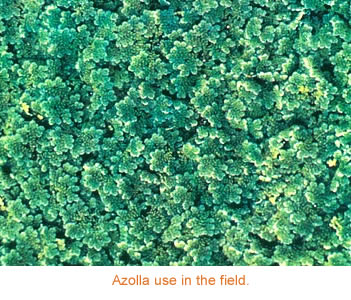Azolla
What is Azolla?
 Azolla is a freshwater water fern that lives in ponds, lakes, swamps, and streams in both tropical and sub-tropical conditions. For many centuries, azolla has been used in southern China and northern Vietnam as green manure for rice.
Azolla is a freshwater water fern that lives in ponds, lakes, swamps, and streams in both tropical and sub-tropical conditions. For many centuries, azolla has been used in southern China and northern Vietnam as green manure for rice.
Why use Azolla in rice?
Azolla in association with blue-green alga anabaena can fix atmospheric Nitrogen (N) into ammonia which can be utilized by rice plant when it is incorporated into soil. Azolla contains from 2−5% N, 0.3−6.0% Potassium (K) (dry weight).
How do you manage Azolla in rice?
Multiplication
- Azolla multiplies vegetatively (i.e., it does not produce seeds). Thus, live Azolla (inoculum) is maintained throughout the year by growing in small ponds or water filled ditches (e.g., areas of 4−5 m2 and depth of 0.5−1 m. You need around 250−500g (fresh weight) inoculum for such an area).
- Azolla grows best at a 25oC average daily temperature but dies at higher temperature. It can be utilized by rice in both wet and dry season.
- Azolla can be used in two ways: 1) as green manure incorporated before transplanting, and 2) as an intercrop incorporated after transplanting.
- In each case, about 500 kg (fresh weight) per ha is introduced into standing water in the rice field.
Pre-transplanting incorporation
- Grow Azolla for about a month before incorporating at transplanting. Fertilize Azolla with 2.2 kg Phosphorus (P)/ha every 5 d, 4 kg K/ha every 10 d, and/or 500−1000 kg/ha farmyard manure every 5−10 d. If chemical fertilizers are unavailable, ash is substituted.
Intercropped Azolla
- Introduce azolla into the rice field when permanent standing water is available. Intercropped azolla is usually not fertilized (but if super phosphate is available one application of 4.5 kg P/ha per crop is recommended).
- Under both systems, azolla can be incorporated several times during the crop cycle.
Rate of growth
- Sixteen to twenty days after inoculation the field is covered with about 20 t of Azolla, which is then incorporated into soil. Normally, some Azolla is left after the first incorporation, which then continues to grow. Sometimes 3−4 crops of azolla are produced and incorporated in each crop of rice.
- This technology produces around 40 t (fresh weight) azolla/ha per rice crop equivalent to around 80 kg N/ha. It requires application of 0.5 t fresh azolla inoculum, 2−3 t farmyard manure, 20−30 kg P, and 20 kg K/ha.
Limitations
- Azolla cannot withstand any drying – so standing water is always required.
- Because Azolla grows from vegetative multiplication, inoculum must be maintained in nurseries all year and multiplied for distribution before field inoculation and multiplication.
- High temperatures cause greater disease and insect attack on azolla. Cool weather is a key to successful Azolla utilization.
- Among nutrients, P is most important for azolla. Since Azolla floats, it is not able to extract P from soil, thus its growth is often constrained by insufficiency of P if P is not applied into the flood water.
- The economics of Azolla use is very important. The technology is labor intensive. Often farmers have little or no economic advantage in choosing azolla over chemical fertilizer because the additional costs of labor, land opportunity irrigation, seed/inoculum, phosphate, and pesticides make the use of Azolla uneconomical.
Developed with input from JK Ladha